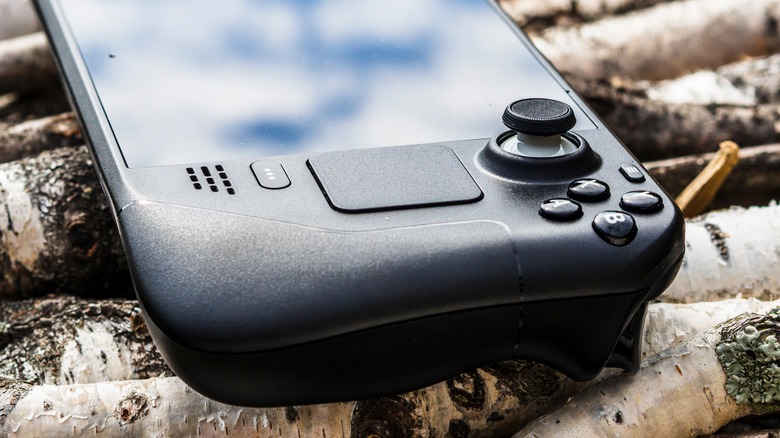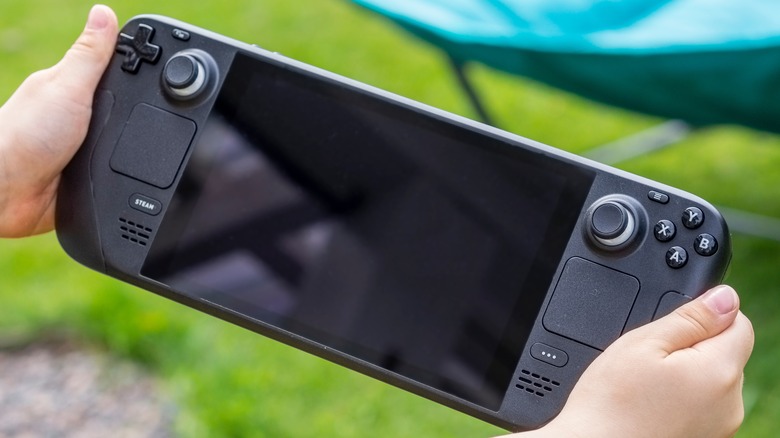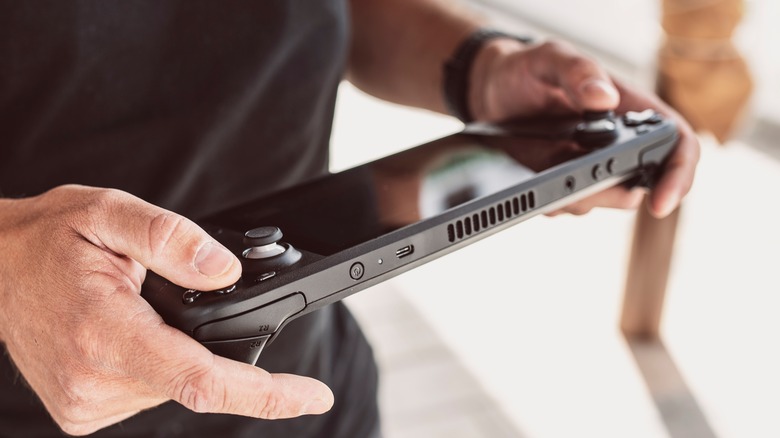Here's How To Fix Your Steam Deck If It Won't Connect To Wi-Fi
The Steam Deck is essentially a gaming PC in handheld form — in fact, you can even download Windows drivers to install the operating system on it. Valve sells an optional dock for the console that makes it possible to use Ethernet (plus USB-C adapters are an option), but generally speaking, you'll spend most of your time on the Steam Deck connected to Wi-Fi. In the same way that some users were seeing slow charger warnings despite using the OEM charger (via Reddit), some Steam Deck owners have reported bugs surrounding Wi-Fi — though, as you'd expect, some of these connection issues are due to user error or problems with the wireless network rather than the console.
Valve has an online support portal with troubleshooting tips and other information designed to help Steam Deck owners overcome problems on their own, and Wi-Fi connectivity woes are included among the topics. Though some solutions are simple, others get a tad more complicated, as they require ensuring the right ports are available for you to use the Steam Deck and play the games you have installed.
How to troubleshoot Steam Deck Wi-Fi connectivity issues
Before exploring more troublesome problems, you should try basic troubleshooting steps to see whether one of them resolves your problem. For example, you may not even be experiencing Wi-Fi issues — rather, Valve's servers may be acting up, which you can verify by heading over to the Steam status page. In other cases, your ISP may be experiencing temporary problems, and waiting a few minutes may be all it takes to get back to your games. If the problem persists, though, you should try restarting your router by unplugging it and then plugging it back in and waiting for it to reconnect.
If other devices you own connect to the Wi-Fi network without issue, you should try restarting the Steam Deck to see whether that fixes the problem. If this still hasn't fixed the issue, Valve recommends in a support document that you try disabling certain router features like quality of service (QoS) and UPnP. The company points out some other possible problems, such as something in the local area interfering with the Wi-Fi network, in which case connecting the Steam Deck to an Ethernet line will restore connectivity until the interference can be mitigated.
Other possible solutions involve switching from a 2.5 GHz to a 5 GHz Wi-Fi network (or vice versa) if your router supports it, or you may need to switch your network over to a different type of authentication protocol, which refers to the kind of technology that secures your Wi-Fi behind a password. Valve explains that the Steam Deck experiences bugs when it comes to the WEP and PEAP protocols, so you may want to try temporarily disabling the password to see if things work like normal again.
Fix Steam Deck Wi-Fi issues by making sure the required ports aren't blocked
The problems you're experiencing with the Steam Deck may be related to port issues, specifically blocked ports Steam needs in order to run. To make things easier, Valve maintains a list of these necessary ports in a support document; you'll need to open them on your firewall and/or your router. This is only possible if you're in control of the router, though — if you're in a dorm room, trying to connect at work, or otherwise using a Wi-Fi network belonging to someone else, you likely won't be able to convince them to unblock the ports, as they have been blocked for a reason.
If this is the source of your problem, the specific aspect of Wi-Fi connectivity you're having trouble with may indicate which ports you need to unblock, as explained by Valve. For example, certain blocked ports may cause issues with using voice chat even if other aspects of the Steam client work; others may cause issues when it comes to downloading games or signing into your account.
The exact process used to open ports varies based on whether you're using Windows or macOS and/or which router model you own. Epic Games has a convenient guide on how to unblock ports in the firewall applications on Windows and Mac. If the problem is with your router, though, you'll need to sign into its admin panel using the credentials found on the device, then open up the necessary ports. Because there are so many different router models on the market, you'll need to consult your device's manual for specific steps, though NordVPN offers a basic guide on the general steps required.
Steam Deck Wi-Fi problems may be caused by your ISP
According to Valve, the problem may not have to do with your router or Steam Deck, but rather your Internet Service Provider (ISP) itself — namely, the company may have some sort of block or setting in place that is interfering with your gaming sessions. Valve lists a handful of ISPs that it says it has determined "block ports required" for the Steam Deck to work properly, including Bluewin, Micronet Broadband, Dutch Telecom, ISPFree, and O12.net. If you're a customer on any of these networks, your Steam traffic may be blocked by the ISP.
You should reach out to your ISP to see about getting the issue fixed, though Valve notes that in at least one instance, you can unblock the ports Steam needs by using the portal provided by the service provider. You may run into an unusual issue, though, that Valve describes in its support document: time-specific connectivity issues.
The company says that if you notice a pattern when your Steam Deck fails to connect properly — that is, problems during the same general time of day — the ISP may be altering your connection during that time, leading to the seemingly random connectivity struggles. If you conclude that this is the problem, Valve says you'll need to contact the service provider to see about getting it resolved on their end.



